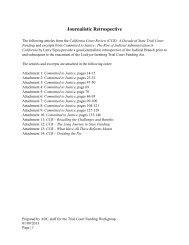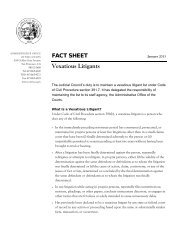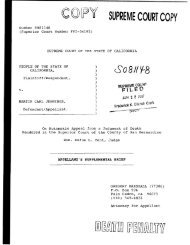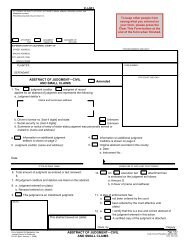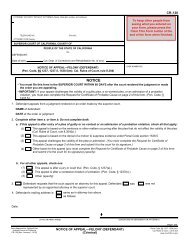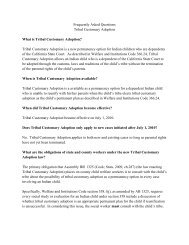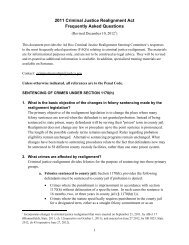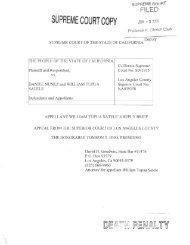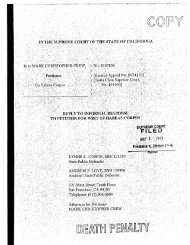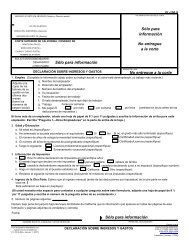f3 THE ,STJIPRE%IE @Ot, W'f' C>t' THE STATE QF C;%kf Fl;lPR%jA
f3 THE ,STJIPRE%IE @Ot, W'f' C>t' THE STATE QF C;%kf Fl;lPR%jA
f3 THE ,STJIPRE%IE @Ot, W'f' C>t' THE STATE QF C;%kf Fl;lPR%jA
You also want an ePaper? Increase the reach of your titles
YUMPU automatically turns print PDFs into web optimized ePapers that Google loves.
<strong>f3</strong> <strong>THE</strong> ,<strong>STJIPRE%IE</strong><strong>@Ot</strong>,<br />
<strong>W'f'</strong> C><strong>t'</strong> <strong>THE</strong> <strong>STATE</strong> <strong>QF</strong> C;<strong>%kf</strong> <strong>Fl</strong>;<strong>lPR%jA</strong><br />
App~al From $be ,:iudgmlcen$ of fk30 SZBPPE"~O~ G::3;k~w#~<br />
The %-$an, K.. 3t.ichzel Sar~i~h, Judge
TABLE OF CONTENTS<br />
APPELLANT'S SUPPLEMENTAL REPLY BRIEF<br />
VII.<br />
SUPPLEMENTAL REPLY CONCERNING<br />
PREJUDICE FROM REFUSAL OF<br />
DEFENDANT'S REQUESTED ACCOMPLICE<br />
CAUTIONARY INSTRUCTION<br />
XI.<br />
SUPPLEMENTAL REPLY ON WHE<strong>THE</strong>R <strong>THE</strong><br />
<strong>THE</strong> <strong>STATE</strong>MENTS OF <strong>THE</strong> ATTORNEYS IN<br />
THIS CASE COULD PROVIDE EVIDENCE TO<br />
QUALIFY <strong>THE</strong> FOREIGN MURDER<br />
CONVICTION FOR A SPECIAL<br />
CIRCUMSTANCE FINDING<br />
CONCLUSION<br />
CERTIFCATION OF WORD-COUNT<br />
Cases<br />
Chapman v. California (1967) 386 U.S. 18<br />
In re Finley (1968) 68 ~al.2"~ 389<br />
People v. Alfaro (1986) 42 ~al.3'~ 627<br />
People v. Andrews (1989) 49 ~al.3'~ 200<br />
People v. Canty (2004) 32 ~al.4'~ 1266<br />
People v. Crowson (1983) 33 ~al.3'~ 623<br />
People v. Dillon (1983) 34 ~al.3'~ 441<br />
TABLE OF AUTHORITIES
People v. Guerrero (1988) 44 Ca1.3'~ 343<br />
People v. Jackson (1985) 37 ~al.3'~ 826<br />
People v. Martinez (2003) 3 1 Cal.4" 673<br />
People v. Myers (1 993) 5 Ca1.4" 1 193<br />
People v. Reed (1 996) 13 Ca1.4" 2 17<br />
People v. Riel (2000) 22 Ca1.4" 1 153<br />
People v. Sims (1993) 5 Ca1.4" 405<br />
People v. Sohal(1997) 53 ~al.~pp.4' 911<br />
People v. Trevino (2001) 26 Cal.4" 237<br />
People v. Trujillo (2006) 40 Cal.4" 165<br />
People v. Watson (1956) 46 ~al.2"~ 818<br />
Statutes<br />
Pen. Code, $ 190.2(a)(2)<br />
Pen. Code, $ 273ab<br />
Pen. Code, 5 667(a)<br />
Pen. Code, $ 1 192.7<br />
Other Authorities<br />
CALJIC No. 8.81.15
Mark D. Greenberg<br />
Attorney at Law<br />
SBN No. 99726<br />
484 Lake Park Avenue, No. 429<br />
Oakland, CA 946 10<br />
5 10-452-3 126<br />
Attorney for Appellant<br />
IN <strong>THE</strong> SUPREME COURT OF <strong>THE</strong> <strong>STATE</strong> OF CALIFORNIA<br />
PEOPLE OF <strong>THE</strong> <strong>STATE</strong> OF CALIFORNIA,)<br />
1<br />
Plaintiff and Respondent,<br />
) SO79179<br />
)<br />
VS.<br />
) Solano No. F-C42606<br />
)<br />
ROBERT ALLEN BACON, )<br />
1<br />
Defendant and Appellant. 1<br />
)<br />
)<br />
SUPPLEMENTAL REPLY BRIEF<br />
VII.<br />
SUPPLEMENTAL REPLY CONCERNING<br />
PREJUDICE FROM REFUSAL OF<br />
DEFENDANT'S REQUESTED ACCOMPLICE<br />
CAUTIONARY INSTRUCTION<br />
In his opening brief, appellant demonstrated that the accomplice cautionary<br />
instruction given in this case was inadequate to forestall an inaccurate assessment<br />
of Charlie Sammons' testimony as somehow less impeachable. The inadequate<br />
instruction also failed to provide a needed check on the prosecutor's specious<br />
claim that his case was somehow more elevated above the morally ambiguous, if
not discreditable, methods of obtaining evidence from criminal witnesses. The<br />
supplemental brief was devoted to examining prejudice from this error in relation<br />
to the special circumstance finding of lying in wait.<br />
In that regard, appellant pointed to the prosecutor's own explanation as to<br />
the importance of Charlie Sammons' testimony to the prosecution's case:<br />
Sammons provided crucial details that helped establish this special circumstance.<br />
(9RT 1944- 1945 .) Respondent answers first superfluously by asserting that there<br />
was no instructional error at all - a position already addressed by appellant in his<br />
reply brief. But responden<strong>t'</strong>s second answer is that there was other evidence of<br />
the special circumstance that rendered Sammons' testimony completely<br />
unnecessary.<br />
As respondent argues, without Charlies Sammons' testimony, the jurors<br />
would have found the lying-in-wait special based on 1) Bill Puengatte's testimony<br />
relating that Charlie had asked Mrs. Sammons to come over the house; 2) on the<br />
forensic evidence showing that Mrs. Sammons had been raped and murdered<br />
inside Charlie's house; and 3) on appellan<strong>t'</strong>s own statements showing that Mrs.<br />
Sammons came to the house. (Supp. RB, pp. 3-4.) This showed, according to<br />
respondent, that "Deborah was specifically lured into the residence where<br />
appellant laid [sic] in wait to rape and murder her." (RB, p. 4.)<br />
The special circumstance of lying-in-wait is imposed when the jury finds<br />
the murder to have been committed during a period of "waiting and watching for<br />
an opportune time to act, together with a concealment by ambush or some other<br />
secret design to take the other person by surprise." In addition, "[tlhe lying in wait<br />
need not continue for any particular period of time provided that its duration is<br />
such as to show a state of mind equivalent to premeditation and deliberation."<br />
(CALJIC No. 8.81.15; People v. Sims (1993) 5 ~ al.4~ 405,433-434.)<br />
Charlie Sammons testified that on October 24, 1994, appellant, in response<br />
to Charlie's animadversions against Mrs. Sammons, offered to kill her. (7RT<br />
1492.) Two days later, Mrs. Sammons was on her way to the house to pay bills
for Charlie. According to Charlie, appellant announced he would wait in the<br />
bedrrom, and that if Sammons "wanted her taken care of," he should just knock on<br />
the bedroom door." (7RT 1487-1488, 1493-1494.) With appellant hidden in the<br />
master bedroom, the couple sat in the kitchen paying their bills. When Mrs.<br />
Sammons went into the master bedroom to put the checkbook away, Charlie, in<br />
his version, sat and waited for the deed to be done. (7RT 1496-1497.) This<br />
testimony, if believed, establishes in clear and precise detail all the elements of<br />
lying-in-wait. Moreover, in this version, one need not depend on whether Charlie<br />
did or did not lure Mrs. Sammons to the house for his homicidal purpose or on<br />
whether or not appellant knew of or shared in this entrapment; appellan<strong>t'</strong>s retreat<br />
into the bedroom, with his admonition to Charlie to give a signal, was all that was<br />
needed for the prosecution's purposes.<br />
What is left when one removes Charlie Sammons' testimony? The forensic<br />
evidence alone does tend to establish that the murder occurred inside the house.<br />
Appellan<strong>t'</strong>s statement also established that the murder occurred inside the house.<br />
As for Puengatte's contribution, it came as follows:<br />
"Q. When you talked to her shortly before 5:00 o'clock, did<br />
she tell you that she was planning to do something else before she<br />
met you?<br />
"A. She said that she had to go to Vacaville to take care of<br />
some bills at her place because Charlie had called her and requested<br />
her to go up there and take care of the bills." (7RT 147 1 .)'<br />
But all this evidence establishes with sufficient certainty to support a<br />
conviction is that Mrs. Sammons went to the Nut Tree House and was murdered<br />
there. More, as the prosecutor, recognized, was required to establish lying-in-wait,<br />
and that more came from the testimony of Charlie Sammons representing<br />
One might note that this testimony might well have encountered a meritorious hearsay<br />
objection if the defense knew that Charlie Sammons was not going to testify.
appellant as hiding in the bedroom, watching and waiting either to emerge on<br />
Charlie Samons' signal or to pounce once Mrs. Sammons entered the bedroom.<br />
But what of appellan<strong>t'</strong>s own more detailed description of events in his<br />
statement to Detective Grate? There, appellant stated that while Charlie and Mrs.<br />
Sammons were in the kitchen, he, appellant, remained in the back yard working<br />
until Charlie went to the store, whereupon appellant took advantage of Charlie's<br />
absence to come into the house to introduce himself to Mrs. Samrnons. (SCT 1"'<br />
pp. 56, 67-69.) Taken at face value, this was "lying in wait" to make a sexual<br />
advance - an act that is not even criminal let alone capital. Indeed, a jury could<br />
have taken this part of appellan<strong>t'</strong>s statement at face value while still rejecting his<br />
claim not to have killed Mr. Samrnons. The jurors could have concluded, for<br />
example, that appellan<strong>t'</strong>s attraction to Mrs. Samrnons was in fact spontaneous, but<br />
that the decision to kill her arose or became firm only after she rejected sexual<br />
advances. If they also could have inferred lying in wait to commit murder as<br />
lurking beneath a prevarication on the part of appellant, the point is that nothing<br />
definite was inferable without the supplement of Charlie Sammons' testimony. In<br />
short, without Charlie Sammons' testimony, the prosecutor, as he himself<br />
recognized, had a severely diminished chance of obtaining a verdict for lying-in-<br />
wait.<br />
So the premise of responden<strong>t'</strong>s argument is wrong, while that of<br />
the trial prosecutor's argument was right: the prosecution needed Charlie<br />
Sammons' testimony to establish the special circumstance for lying in wait.<br />
Without an adequate cautionary instruction, Charlie's credibility was unduly<br />
enhanced in this case, if not to the point of undermining confidence in the jury's<br />
verdict for murder, then certainly to the point of undermining confidence in the<br />
special circumstance finding. (People v. Watson (1956) 46 ~al.2"~ 818, 836-837;<br />
Chapman v. California (1 967) 386 U.S. 1 8'23-24.) At the very least, this finding<br />
must be reversed.
XI.<br />
SUPPLEMENTAL REPLY ON WHE<strong>THE</strong>R <strong>THE</strong><br />
<strong>THE</strong> <strong>STATE</strong>MENTS OF <strong>THE</strong> ATTORNEYS IN<br />
THIS CASE COULD PROVIDE EVIDENCE TO<br />
QUALIFY <strong>THE</strong> FOREIGN MURDER<br />
CONVICTION FOR A SPECIAL<br />
CIRCUMSTANCE FINDING<br />
Appellant contended, and contends, that his Arizona murder conviction<br />
could not be used as a special circumstance because the least adjudicated elements<br />
of that conviction did not qualifL as murder in California. Among the evidence<br />
discussed was the competing, but unadjudicated representations of the prosecutor<br />
and defense counsel recorded in a transcript of the Arizona plea proceedings.<br />
Appellant contended that those representations did not provide sufficient evidence<br />
to bring appellan<strong>t'</strong>s underlying conduct within the definition of murder in<br />
California. (AOB, pp. 142-148.) In the reply brief and supplemental opening<br />
brief, appellant maintained this position, but added that these statements by<br />
counsel were not competent or admissible to prove that a foreign murder<br />
conviction conformed to California law. As appellant argued, the scope of<br />
competent evidence allowable for the prior murder special is more narrowly drawn<br />
than that allowed for other enhancement penalties prescribed in other statutes for<br />
prior convictions or prior prison terms.<br />
Respondent cites this Cour<strong>t'</strong>s opinion in People v. Trevino (2001) 26<br />
~a1.4'~ 237 for the proposition that for the prior murder special circumstance, it is<br />
"conduct" that is at issue, and therefore not, presumably, only the elements of the<br />
crime. Thus, in the prior murder conviction, just as in any other prior conviction<br />
used for recidivist enhancement, the competent evidence embraces "the entire<br />
record of conviction." (People v. Guerrero (1988) 44 ~al.3'~ 343, 352.) The<br />
"entire record of conviction," as respondent argues, includes representations by<br />
counsel at a plea colloquy -- a proposition for which respondent finds support in<br />
People v. Sohal(1997) 53 ~ a l . ~ ~ 91 ~ 1. .(Supp. 4 ' ~ Resp. Brief, pp. 9-10.) As will
e demonstrated by appellant, however, even if a prior murder special is to be<br />
treated the same way as other recidivist enhancements and subject to the rule in<br />
Guerrero, that rule does not accommodate the statements at issue here. Appellant<br />
will also go further, and demonstrate that the prior murder special is subject to a<br />
narrower test that consists only in identifying the foreign prior of which the<br />
defendant was convicted, and then analyzing its defined elements in comparison<br />
with the elements of first or second degree murder as defined in California.<br />
Again, if one assumes for the sake of argument that the Guerrero governs<br />
the prior murder special circumstance, the statements of counsel made in this case<br />
are still incompetent. In regard to the Guerrero test, the crux of the dispute<br />
between appellant and respondent is not of course whether the record of<br />
conviction can be used to prove a prior murder special. There is no other way to<br />
prove a prior murder special circumstance except by means of the record of<br />
conviction. The question is whether the "record of conviction" is conceived<br />
narrowly or broadly as to the amount of information that is deemed to be<br />
admissible and competent in order to prove the underlying conduct beyond the<br />
defined elements of the crime of conviction. This dispute is not resolved by<br />
whether or not the phrase "entire record of conviction7' applies, since this Court<br />
has yet to explicitly fix a dispositive definition of what this means (People v.<br />
Guerrero, supra, 44 ~al.3'~ at p. 356, fh. 1), except to provide alternative, but not<br />
necessarily congruent, definitions. In People v. Reed (1 996) 13 Ca1.4" 2 17, this<br />
Court identified the record of conviction as either the record on appeal or, more<br />
narrowly, "only those record documents reliably reflecting the facts of the offense<br />
for which the defendant was convicted.?' (Id. at p. 223.)<br />
On the other hand, this Court seems to have implied a choice by opting in<br />
practice for the narrower alternative set forth in Reed. In People v. Trujillo (2006)<br />
40 ~al.4'~ 165, it was ruled that the defendan<strong>t'</strong>s statements in a probation report<br />
could not be deemed part of the "record of conviction" for purposes of proving a<br />
prior conviction enhancement. The rationale for this ruling was that such
statements made to a probation officer after entry of a plea "do not 'reflect [I the<br />
facts of the offense for which the defendant was convicted."' (Id., at p. 179.) This<br />
is the narrower test set forth in Reed, and indeed, the internal quotation marks refer<br />
to Reed. When one considers also that a probation report is certainly a part of the<br />
record on appeal, the conclusion seems safe that the test for recidivist<br />
enhancements takes a narrow view of the scope of the "record of conviction."<br />
rthis same test applies to the prior murder special, then it is fairly certain<br />
that the statements by the prosecutor and defense counsel made in the plea<br />
proceedings in Arizona fail. The statements cannot be deemed reliably to reflect<br />
the facts of the offense. The adversarial representations were inconsistent with<br />
each other. Neither counsel stipulated to the representation of the other counsel.<br />
And the presiding judge made no adjudication as to which set of facts were<br />
deemed to inform the imminent guilty plea that appellant was to enter. If, in<br />
Trujillo, a direct statement by the defendant to his probation officer could not be<br />
used to supplement the evidence and show the defendan<strong>t'</strong>s underlying conduct,<br />
then a fortiori the second-hand, conflicting representations by counsel are not<br />
within the "record of conviction." People v. Sohal(1997) 53 Cal.~~~.4'~<br />
911, if it<br />
even survives Trujillo, has no effect on the conclusion in this case since Sohal<br />
invovled a stipulation by defense counsel to the prosecutor's representation of the<br />
facts predicating the guilty plea. (Id. at pp. 914-91 5.)<br />
Thus, if the Guerrero test, which applies to both domestic and foreign prior<br />
convictions for recidivist enhancements (People v. Myers (1993) 5 ~al.4'~ 1193,<br />
1200-1202; People v. Riel (2000) 22 ~ al.4'~ 1153, 1205), also applies to the prior<br />
murder special in Penal Code section 190.2(a)(2),.then appellant is still correct:<br />
the statements of counsel in the plea transcript are not cognizable for establishing<br />
the eligibility of the Arizona murder conviction for treatment as a special<br />
circumstance in this case.<br />
But appellan<strong>t'</strong>s actual position goes farther. What constitutes the "record of<br />
conviction" for the prior murder special is drawn even more narrowly. The reason
for this is not policies set forth in this or that opinion by this Court in regard to<br />
recidivist enhancements under other statutory schemes, but because Penal Code<br />
section 190.2(a)(2) itself confines the matter to 1) documentary evidence that<br />
identifies the foreign crime of conviction, and 2) the least adjudicated elements of<br />
that crime as defined.<br />
Penal Code section 190.2(a)(2) allows a foreign murder conviction to be<br />
used as a special circumstance when the "offense committed in another<br />
jurisdiction . . . would be punishable as first or second degree murder" in<br />
California. An "offense in another jurisdiction" must therefore be the equivalent<br />
of California's first or second degree murder. The latter are clearly defined<br />
offenses in the California Penal Code and in the case law construing the relevant<br />
statutory provisions. "Offense" is a legal term denoting a statutory or common<br />
law definition of a proscribed act for which there is a criminal punishment. (See<br />
Pen. Code,<br />
15.) There is nothing in section 190.2(a)(2) that suggests that<br />
specific, underlying conduct beyond that necessary to satisfy the definitional<br />
elements of the foreign prior is at issue in the prior murder special circumstance.<br />
One would think that the plain meaning of the statute supports appellan<strong>t'</strong>s position<br />
that the test for a foreign prior murder conviction is the narrow test based on the<br />
elements of the crime of conviction compared with the elements of California<br />
murder.<br />
But in People v. Martinez (2003) 3 1 ~a1.4' 673, this Court left it an open<br />
question whether the "facts and circumstances underlying the offense to which<br />
defendant pleaded guilty" can be consulted as evidence to establish the prior<br />
murder special or whether the "elements" test of People v. Andrews (1989) 49<br />
~al.3 rd 200 was the appropriate measure. (People v. Martinez, supra, 31 ~a1.4" at<br />
p. 688.) If the matter were simple, one would expect no reticence in proncouncing<br />
even in dicta either that the elements test controlled or that the then 15 year-old<br />
(and now 20 year old) Guerrero decision controlled.
The recidivist enhancement at issue in Guerrero was the serious felony<br />
enhancement of Penal Code section 667(a), which incorporated the list of serious<br />
felonies set forth in section 1192.7. This list included defined crimes, but it also<br />
included descriptions of conduct that fit no definition of a public offense. In<br />
Guerrero it was "burglary of a residence," which went beyond the statutory<br />
definition of burglary. It was in this context that Guerrero developed its rule<br />
regarding the "entire record of conviction," since underlying conduct was, of<br />
necessity, at issue in the enhancement.<br />
In People v. Myers, supra, 5 ~al.4'~ 1193, the Court was confronted with<br />
whether the Guerrero rule applied to foreign priors under section 667(a). The<br />
provision for foreign priors in that statute requires that "any offense committed in<br />
another jurisdiction . . . include[] all of the elements of any serious felony . . ." -<br />
language that seems just as plain as that in Penal Code section 190.2(a)(2).<br />
However, in Myers, this Court noted that the intent of the electorate, which<br />
enacted section 667(a) in 1982, was that underlying conduct was the issue even for<br />
the domestic priors. This was clearly evidenced by the list of serious felonies that<br />
included descriptive conduct as well as defined offenses. There was no suggestion<br />
that the electorate was led to believe that foreign priors were to be treated any<br />
differently. (People v. Myers, supra, at pp. 1 1 99- 1200.)<br />
Section 190.2(a)(2) was also an electoral enactment in 1978 as part of the<br />
death penalty law enacted that year. Further, the prior murder special of that year<br />
is identical to the death penalty law enacted legislatively in 1977. (People v.<br />
Andrews (1989) 49 ~al.3'~ 200, 222; People v. Trevino, supra, 26 ~al.4'~ 237,<br />
24 1 .) What did the 1977 Legislature and the 1978 electorate intend? Was it the<br />
same intention manifested by the 1982 electorate that enacted Section 667(a)?<br />
There is strong reason to doubt it.<br />
First, fiom the domestic pole, there are no descriptive murder convictions<br />
that qualify for special circumstance treatment. Thus for example, a defendant<br />
with a prior conviction for a violation of California's Penal Code section 273ab,
assault resulting in the death of a child under 8, which is defined as the deadly<br />
application of "force that to a reasonable person would be likely to produce great<br />
bodily injury," cannot be rendered qualified for treatment as a prior murder special<br />
by evidence in the record of conviction that shows the actual crime to have been<br />
committed with implied or express malice aforethought. There is simply nothing<br />
in the structure or language of Section 190.2(a)(2) that would tolerate such a<br />
result, and this distinguishes section 190.2(a)(2) form section 667(a). For if, per<br />
Myers, the treatment of domestic priors signals the intended treatment of foreign<br />
priors, then for 190.2(a)(2), one must assess foreign priors based only on their<br />
adjudicated elements as a matter of statutory mandate.<br />
Secondly, the rule in Guerrero was also based on what purported to be a<br />
correction of the misreading of In re Finley (1968) 68 ~al.2"~ 389. In Finley, a<br />
case dealing with the recidivist sentencing statute that existed at that time, this<br />
Court stated that "unless the record . . . established the adjudicated elements of the<br />
previous offense, the court will assume that the prior conviction was for the least<br />
offense punishable under the foreign statute. (Id. , at p. 39 1, emphasis added.)<br />
Further, the suggestion in Finley was that there was only so far one could go to<br />
establish the adjudicated elements since "[rileither the People nor the defendant<br />
can go behind those adjudicated elements in an attempt to show that he committed<br />
a greater, lesser, or different offense." (Id. at p. 393.) This language was<br />
understood to mean that the assessment of prior convictions was confined to the<br />
adjudicated elements test, and in three decisions dealing with recidivist<br />
enhancement statutes, including section 667(a), this Court so understood the<br />
formulations in Finley. (People v. Crowson (1983) 33 ~al.3'~ 623,632, 634;<br />
People v. Jackron (1985) 37 ~al.3'~ 826, 834-836; People v. Alfaro (1986) 42<br />
~al.3'~ 627.)<br />
Guerrero held that these cases all misread Finley, whose holding in fact<br />
allowed evidence of underlying conduct derivable fiom the record of conviction,<br />
but applied the elements test only when such information was not available.
(People v. Guerrero, supra, 44 ~ al.3~~ at pp. 348-355.) Whether or not Guerrero<br />
is correct, however, is immaterial. What is material is how the 1977 Legislature<br />
and the 1978 electorate understood the test for a prior conviction. That the<br />
"misunderstanding" of Finley was the predominant understanding of the law from<br />
1968 through 1988 when Guerrero appeared is established by the opinions in<br />
Crowson, Jackson, and Alfaro. A misunderstanding of the law that is nonetheless<br />
lawfblly enacted as law is the law. (People v. Dillon (1983) 34 ~a1.3" 441, 471-<br />
472.)<br />
Thirdly, there is the rule of lenity, which holds that where there is more<br />
than one reasonable interpretation of a penal statute otherwise unclear, the<br />
interpretation most favorable to the criminal defendant prevails. (People v. Canty<br />
(2004) 32 Ca1.4" 1266, 1277.) In the instant case, given the use of the word<br />
"offense" in the statute, given the plausible understanding of Finley as establishing<br />
an adjudicated elements test, and given that this plausibility was vouchsafed by<br />
this Cour<strong>t'</strong>s own opinions in Crowson, Jackson, and Alfaro, one is thereby forced<br />
to conclude that Penal Code section 190.2(a)(2) is governed by the adjudicated<br />
elements test.<br />
Finally, what of responden<strong>t'</strong>s claim that this Court in People v. Trevino,<br />
supra, 26 ~al.4'~ 237 has held that under section 190.2(a)(2), underlying conduct<br />
is at issue? The difficulty is that Trevino does not use the term "underlying<br />
conduct," but only the term "conduct" in a context that seems to mean no more<br />
than the conduct defined by the elements of the crime. At issue in Trevino was<br />
whether a Texas murder conviction of defendant when he was 15 years old could<br />
be used as a prior murder special, when in California, a 15-year-old could not be<br />
tried as an adult for murder. The Court rejected the defendan<strong>t'</strong>s claim and held<br />
that the prior conviction was not disqualified because of this discrepancy between<br />
Texas and California law:
"The provision we must construe reads: 'For the purpose of<br />
this paragraph, an offense committed in another jurisdiction, which<br />
if committed in California would be punishable as first or second<br />
degree murder, shall be deemed murder in the first or second<br />
degree.' (5 190.2, subd. (a)(2).) According to the ordinary meaning<br />
of this text, a conviction in another jurisdiction may be used if the<br />
'offense' would be punishable as first or second degree murder if<br />
committed in California. Thus, the focus is on the conduct, not the<br />
age or other personal characteristics of the person who engaged in<br />
that conduct. It is the offense, and not necessarily the offender, that<br />
must satisfy statutory requirements for punishment under California<br />
law as first or second degree murder." (Trevino, supra, at p. 24 1 .)<br />
The term "conduct7' was used as a contrast to the concept of the criminal<br />
defendan<strong>t'</strong>s legal status as a person quite apart fiom the criminal conduct itself.<br />
There is nothing here to imply any more than that the actions proscribed<br />
definitionally by the foreign statute are at issue. In this regard, Trevino relies on<br />
People v. Andrews, supra 49 ~al.3'~ 200, which held that the absence of a<br />
procedure in Alabama equivalent to a juvenile fitness hearing for defendants<br />
between the ages of 16 and 18 in California did not prevent the use of the prior in<br />
that case as a special circumstance. Andrews, instead of the term "conduct," used<br />
expressly the term "elements":<br />
"In some states a defendant is not entitled to a preliminary<br />
hearing. [Citations.] In others, a jury consisting of fewer than 12<br />
persons can determine guilt. [Citation.] In still others there is no<br />
fitness hearing to determine whether a 16 year-old should be treated<br />
as an adult. While any one of these procedural differences might<br />
conceivably spell the difference between a murder conviction and<br />
some other result, nothing before us indicates that the Legislature, in<br />
enacting the 1977 death penalty legislation, or the electorate, in later<br />
duplicating its language, intended that the prosecution's ability to use<br />
convictions fiom other states should turn on such questions. Rather,<br />
it appears the intent was to limit the use of foreign convictions to<br />
those which include all the elements of the offense of murder in
California, and defendant has failed to show otherwise." (People v.<br />
Andrews, supra, at pp. 222-223.)<br />
There is no difference whatsoever between Trevino's "conduct" and Andrews<br />
"elements." Responden<strong>t'</strong>s claim that Trevino holds against appellan<strong>t'</strong>s position is<br />
meritless.<br />
However one approaches the problem then, the statements of counsel at the<br />
plea proceedings in the Arizona case are not admissible or competent evidence to<br />
establish the prior Arizona murder conviction as a special circumstance under<br />
Section 190.2(a)(2). Under the Guerrero test, they are not part of the "record of<br />
conviction." Under the so-called "elements" test for the special circumstance,<br />
they contain unadjudicated material that exceed the definitional elements of the<br />
crime of conviction. Finally, as noted in the opening brief, even if they are<br />
considered, they do not add any evidence of sufficiently ponderable weight to<br />
show that appellant was not convicted of a form of Arizona second-degree murder<br />
that clearly falls outside the definition of murder in California. The special<br />
circumstance finding of prior conviction for murder must be reversed.
CONCLUSION<br />
For the reasons set forth in appellan<strong>t'</strong>s briefs, if his murder conviction is not<br />
reversible, then, at least, the special circumstances for lying-in-wait and for prior<br />
murder conviction are.<br />
Dated: April 7, 2008<br />
Respecthlly submitted,<br />
I<br />
fl<br />
Mark D. Greenberg<br />
P<br />
Attorney for Appell t
CERTIFICATION OF WORD-COUNT<br />
I am attorney for appellant in the above-titled action. This petition has been<br />
produced by computer, and in reliance on the word-count function of the computer<br />
program used to produce this document, 1 hereby certify that, exclusive of the<br />
table of contents, the attached court of appeal decisions, and this certificate, this<br />
document contains 4 134 words.<br />
Dated: April 8, 2008<br />
Mark D. Greenberg<br />
Attorney for Appellants
[CCP Sec. 1013A(2)]<br />
The undersigned certifies that he is an active member of the State Bar of<br />
California, not a party to the within action, and his business address is 484<br />
Lake Park Avenue, No. 429, Oakland, California; that he served a copy of<br />
the following documents:<br />
SUPPLEMENTAL REPLY BRIEF<br />
by placing same in a sealed envelope, fully prepaying the postage thereon,<br />
and depositing said envelope in the United States mail at Oakland,<br />
California on April 9, 2008, addressed as follows:<br />
Attorney General<br />
455 Golden Gate Ave., No. 11000<br />
San Francisco, CA 94 102<br />
Superior Court<br />
Hall of Justice<br />
600 Union Ave.<br />
Fairfield, CA 94533<br />
District Attorney<br />
600 Union Ave.<br />
Fairfield, CA 94533<br />
Scott Kaufhan<br />
California Appellate Project<br />
10 1 Second Street, Ste. 600<br />
San Francisco, CA 94 105<br />
Robert Allen Bacon, P-4 1600<br />
San Quentin State Prison<br />
San Quentin, CA 94974<br />
I declare under penalty of perjury that the foregoing is true and<br />
correct and that this declaraton was executed on April 9, 2008 at Oakland,<br />
California.<br />
Mark D. Greenberg<br />
Attorney at Law



